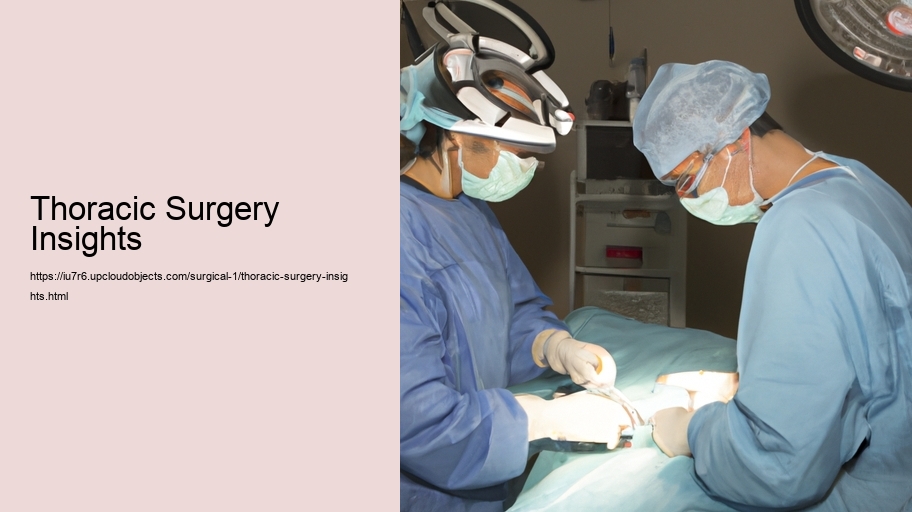Thoracic Surgery Insights: Peering into the World of Chest Medicine
Thoracic surgery, an intricate and dynamic field of medicine, encompasses the surgical treatment of diseases affecting organs inside the thorax-the chest-primarily including the heart, lungs, and esophagus. This specialty has seen a remarkable journey of innovation and advancement that has transformed patient outcomes and recovery processes. In this essay, we delve into the key insights that define thoracic surgery, from its historical roots to the cutting-edge techniques shaping its future.
The origins of thoracic surgery can be traced back to a time when the prospects of opening the chest cavity were met with trepidation due to the complex anatomy and the vital functions of the organs contained within. Early procedures were limited and often only palliative. However, the 20th century ushered in a golden era of medical breakthroughs. Pioneering surgeons, armed with a better understanding of anesthesia and aseptic techniques, began to push the boundaries of what was possible.
The evolution of thoracic surgery is closely linked with the development of cardiopulmonary bypass machines, which allowed for open-heart surgeries and complex lung operations by temporarily taking over the function of the heart and lungs during the procedure. This innovation expanded the horizon of thoracic surgeries, making them safer and more successful.
Today, thoracic surgery has embraced less invasive approaches, such as video-assisted thoracoscopic surgery (VATS) and robotic surgery. These methods involve using specialized instruments and small incisions, which result in less pain, reduced risk of infection, and quicker recovery times for patients. The precision of these minimally invasive techniques also facilitates surgeries that are more complex and tailored to the individual patient's pathology.
Lung cancer surgery is one of the most common and challenging aspects of thoracic surgery. Surgeons must navigate the delicate balance between removing enough tissue to ensure all the cancer is excised while preserving as much lung function as possible. As screening for lung cancer improves and diagnoses are made earlier, thoracic surgeons are often able to perform less extensive surgeries, which can lead to better postoperative outcomes and quality of life.
Heart surgery is another cornerstone of thoracic surgery, with procedures ranging from coronary artery bypass grafting to heart valve repair and replacement. Innovations in this area include transcatheter valve replacements, which allow for valve repair or replacement without the need for open-heart surgery. Such advances have made heart surgery an option for a broader range of patients, including those for whom traditional surgery would be too risky.
Another critical insight in thoracic surgery is the importance of a multidisciplinary approach. Collaboration between thoracic surgeons, pulmonologists, oncologists, cardiologists, radiologists, and other specialists is essential to provide comprehensive care. This team approach ensures that all aspects of a patient's health are considered when planning surgical interventions, which can lead to better outcomes and more personalized treatment strategies.
The postoperative care in thoracic surgery is as crucial as the surgery itself. Pain management, respiratory therapy, and careful monitoring are essential aspects of recovery. Enhanced recovery after surgery (ERAS) protocols are becoming increasingly popular in thoracic surgery. These protocols are designed to reduce complications, shorten hospital stays, and promote a faster return to normal activities through a combination of preoperative, intraoperative, and postoperative strategies.
Looking to the future, thoracic surgery continues to be at the forefront of medical innovation. Research into stem cell therapies, gene editing, and tissue engineering holds the potential to revolutionize the treatment of thoracic diseases. As the field progresses, there is also a growing emphasis on personalized medicine-using genetic and molecular profiling to tailor treatments to the individual patient for maximum efficacy.
In conclusion, thoracic surgery is a field marked by continual growth and innovation. Surgeons in this specialty navigate a complex interplay of technical skill, clinical decision-making, and collaborative care. As technology advances and our understanding of thoracic diseases deepens, thoracic surgery will continue to offer new hope and improved outcomes for patients facing some of the most challenging medical conditions. The insights gained from this ever-evolving discipline are not just shaping the world of chest medicine; they are transforming the landscape of healthcare as a whole.
